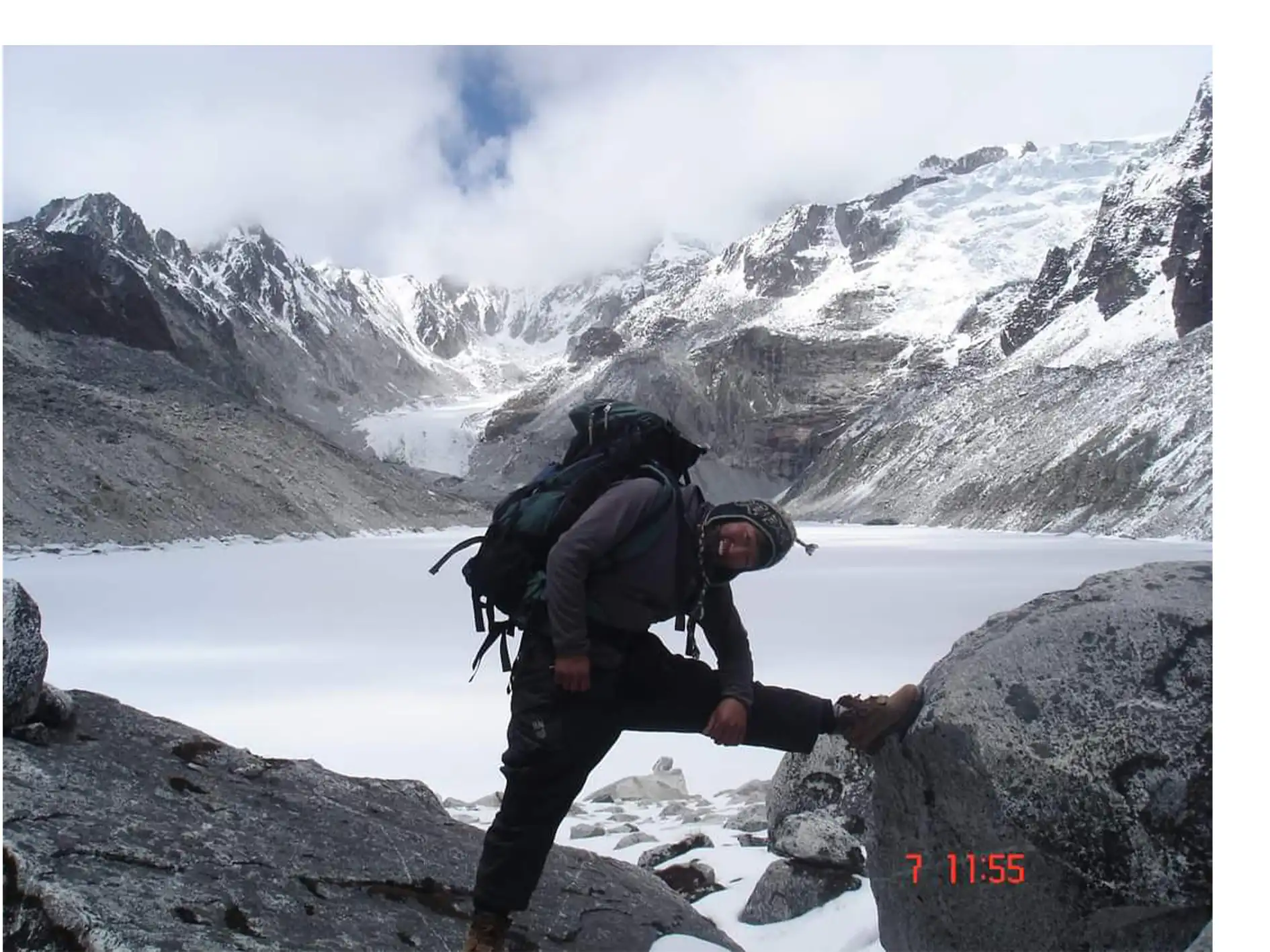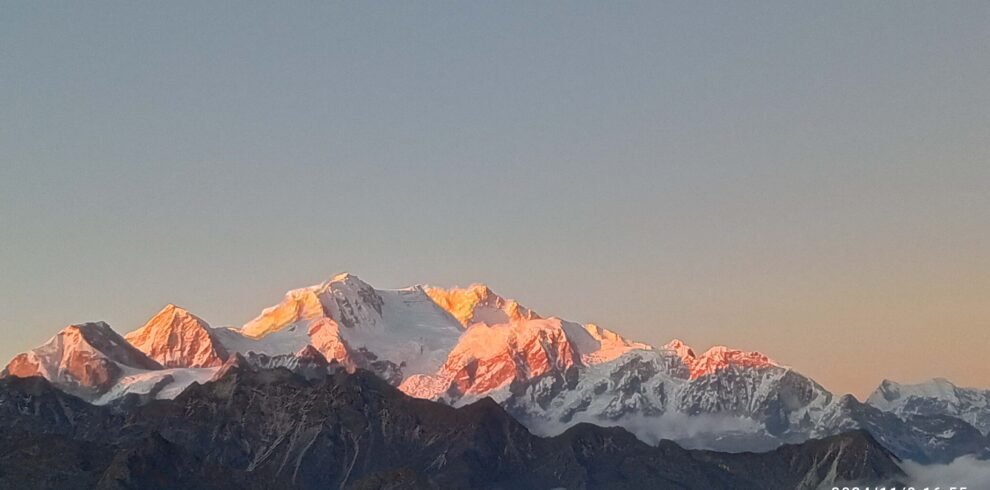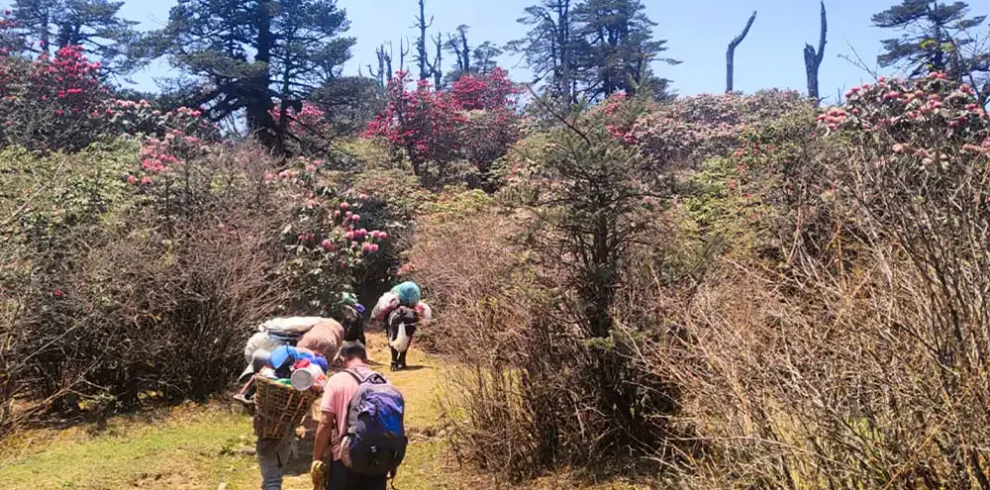Puspa Lake Trek
About Puspa Lake Trek.
The Puspa Lake Trek, located in West Sikkim, offers an incomparable trekking experience through the Himalayas. This trek allows adventurers to explore the region’s natural beauty while experiencing the unique cultural traditions of the local communities. Puspa Lake, nestled amidst some of the most stunning landscapes, is a perfect destination for those seeking tranquility and adventure.
The trek is typically categorized as an easy to moderate-level trek, making it accessible for both seasoned trekkers and beginners. It generally lasts 11 to 12 days and covers a distance of approximately 94 kilometres. The trail encompasses a variety of terrains, including lush forests, alpine meadows, and rugged mountainous paths.
Overview:
- The Puspa Lake is one of the most unexplored treks in the region. Very few people know this is a possible route, and only a few people have been there. The lake itself was only a symbol on the map till Puspa Lall Gurung, the founder of Black Yak expedition, then working as a technical guide for scientists from a research institute in Gangtok, led the scientists to the lake in 2006. They were studying high-altitude lakes in the region, and Puspa job was to find and lead them to the lakes. This is one of the great treks that emerged from this research.
- The scientist team had two Indian scientists from Kolkata, and three were local scientists from Sikkim.
- Those two Indian scientists did not go to the lake; they rested in the camp all day with the three local scientists, Mr Pranay, Mr Shafel, Mr RK and myself, Puspa. We went and studied the lake, an unnamed lake.
- After studying the unnamed lake, they decided and advised the lake should be named Puspa Lake.
Best Time to Visit Puspa Lake Trek
- Choosing the optimal time to visit Puspa Lake is paramount for a magnificent experience. The weather and landscape change significantly through the different seasons, influencing trekking conditions and the atmosphere. Here are vital factors to consider:
Seasons
Spring (March to May)
- Weather: Pleasant and moderate temperatures ranging from 10°C to 20°C.
- Advantages: Lush greenery, blooming rhododendrons, and azaleas enhance the natural beauty. Visibility is excellent, perfect for photography.
- Disadvantages: Occasional rain showers might occur.
Summer (June to August)
- Weather: Warm temperatures averaging between 15°C and 25°C. (Monsoon season leads to frequent, heavy rains, resulting in slippery and muddy trails. The risk of landslides is higher.)
Autumn (September to November)
- Weather: Cool and dry with temperatures between 7°C and 18°C.
- Advantages: Clear skies offer breathtaking views of the surrounding peaks. Foliage changes colour, providing a picturesque backdrop.
How to Reach Puspa Lake Trek Base Camp
- Nearest Airport
The nearest airport (IBX):
- The nearest Bagdogra Airport to Yuksom is approximately 152 kilometers away. It connects to several major cities in India, including Delhi, Kolkata, Guwahati and Siliguri.
Nearest Railway station NJP:
- The nearest railway station NJP to Yuksom is approximately 155 kilometres from Yuksom, NJP is well connected to major cities across India. Here’s a step-by-step guide on how to reach Yuksom via train:
- If you decide to reach Yuksom by shared jeep, there are breakpoints on the route to keep in mind. So this section will discuss How to get to Yuksom by shared jeep.
- Catch a taxi and come to Siliguri city SNT Bus Stand, but Siliguri Junction is recognized well. Once you get to Siliguri SNT /Junction, ask for Jorethang share cab. From there, come to Jorethang by the shared car.
- The distance from Siliguri to Jorethang is around 81.9 kilometres. And it can take up to 3 hours. In Jorethang, climb to the third floor of the stand and ask for the Yuksom taxi stand. Anyone will direct you there.
- Please note that a Shared cab from Jorethang will leave for Yuksom within 1 PM. So, you have to strive to reach Jorethng before noon. Still, there is no guarantee that you will get vacant. Locals pre-book the shared jeeps. In most cases, only one shared jeep runs regularly on this route.
Notice:
- (Luggage) during the trekking period, you may leave your luggage at your Hotel, Homestay, or Black Yak Expeditions Office in Yuksom. (This is for the luggage you won’t need during the trek and can be retrieved when you return.)
Withdrawing cash:
- If you intend to visit Sikkim like Yuksom Or Goechala trek don’t expect to withdraw cash in Yuksom because it does not have ATM services in Yuksam until updated in the year 2025
Safety and Navigation
- Personal Gear (Participants Need to Bring)
Clothing:
- Moisture-wicking base layers (thermal tops and bottoms) 2pair.
- Insulated jackets (down or synthetic).
- Waterproof and windproof jackets and pants.
- Comfortable trekking pants 2 pairs.
- Worm gloves 1. set. and Buffs or neck gaiters 1. pair.
- Waterproof Ankle shoes and camp footwear for evenings.
- Socks carry about 3-4 pairs of good sports socks.
- Rain cover make sure your pack has a rain cover, too.
- Underclothes: Carry about 3 sets of underclothes.
- Thermal inners: You might want to carry a set of thermal inners.
- T-shirts: 3 T-shirts (full sleeve if u are susceptible to feeling cold).
- The quick-dry sports T shirts are the best as far as our experience goes.
- Cap/Head: A good balaclava (monkey cap).
- Personal first aid kit: You should carry a small personal firaid kit. In case you do the following things could be a part of your list
Accessories and Day Pack
-
- Daypack with a capacity of 20-30L
- Hydration system or water bottles
- Sunglasses with UV protection
- Headlamp with extra batteries
- Personal identification and necessary permits
Personal Items Basic toiletries
- Carry basic toiletries – Tooth Brush, paste, shop
- A small bottle of moisturizer, perhaps a bottle of hand sanitiser, is also very handy.
- Sunscreen and lip balm with SPF
- Lightweight towel
- Personal medications and vitamins
Notice:
- If you are any personal illness, like a Asthmatic please bring your medication and carry with you.
- Carrying all the gear in plastic bags for additional protection inside the sack is advisable.
Document to carry on the trek for (Indian client)
- Indian Identity -Aadhar card, Voter-Id card, Drivers licence and PAN card. ( 3 copies)
- Passport size Photo-copies (3 Pc.)
Document to carry on the trek for (Foreign Client)
- Foreign nationals will also have to get the Inner Line Permit made at the Melli check post while entering Sikkim en route from NJP/Bag-Dogra airport. Without the Inner Line Permit, trekking permits will not be issued.
- Special trekking permit as per regulations, made from Pelling/ Yuksom Department of Tourism.
- Black yak expedition requires a special trekking permit from the Department of Tourism. You are not allowed to trek before obtaining a Trekking Permit.
- If you Please reach Uttarey at least a day before the trek, it is best for us. We need to obtain a special trekking permit at Pelling/Yuksom
- Black Yak Expedition can help you obtain these permits. As per regulations, your trekking permit can be obtained only after obtaining your Sikkim Inner Line Permit (ILP).
- An Inner Line permit can be obtained at main checkpoints or border areas, such as Melli and Rangpo in Sikkim. It can also be obtained at Bagdogra Airport or the Silliguri Kachahari area.
Document Required for Trekking Permit
- Original passport photocopy 3 pc.
- Original India Visa photocopy 3 pc.
- Original Sikkim Inner Line Permit photocopy 3 pc.
- Passport Size Photography photocopy 4 pc.
- Undertaking / Disclaimer.
Trip Highligts
- Scenic Beauty: The trek offers mesmerizing views of the Kanchenjunga range, which is the third-highest mountain peak in the world. Trekkers can enjoy breathtaking sunrises and sunsets over the majestic snow-capped peaks.
- Biodiversity: The route is rich in flora and fauna. trekkers can witness a variety of species, including the Red Panda and different types of alpine flowers.
- Cultural Experience: The trek routes pass through several remote monasteries before Tibetan villages, providing trekkers with a glimpse into the traditional lifestyles and cultures of the local Sikkimese communities.








